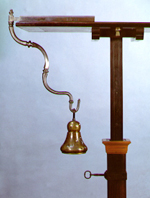
39 x 31.4
Iron
INDEX 1788 : B.IV.93
Ferrem ex parte rectum, et ex parte curvum in uncum desinens, quod parte recta in vaginam ferream immittitur.
Iron piece, one part straight and one part curved ending in a hook; the straight part of which goes into an iron casing.
This device is used to show that a body will remain in equilibrium as long as a vertical line passing through its centre of gravity intersects with the body's surface of support: the equilibrium will be stable if the body's centre of gravity is below its point of support. The apparatus consists of a piece of iron, one part being straight, with a square cross section, and the other part curved, with a hook-shaped end bearing a fairly heavy weight. The whole of the straight side fits exactly into an iron casing.
In experimental physics classes, the teacher holds the casing on a table, so that the weight can hang down below the table and move as the straight part is pushed in and out of the casing. When it is pulled out, it brings the hanging weight near the vertical line at the edge of the table top, and the centre of gravity of the apparatus moves in the same direction. When the vertical line passing through the centre of gravity intersects the surface of the table supporting the casing, a balance is achieved, even though the point of connection between the straight and the curved sections of the iron piece is some distance away from its support.
If the part holding the object is pulled almost completely out of the casing, so that the centre of gravity is on a vertical line which does not intersect with the table top, the casing will tilt, and the hanging object will move nearer to the vertical line at the edge of the table. Under these conditions, the apparatus will be supported on the table only by a supporting line which is transverse to the longitudinal axis of the casing. The balance position requires that this line be above the centre of gravity of the apparatus. If the equipment is moved so that the vertical line passing through the centre of gravity does not intersect with the supporting line, then it will begin an oscillatory motion, gradually damped until the position of equilibrium is achieved.
From Colégio dos Nobres, catalogue n.º 86.